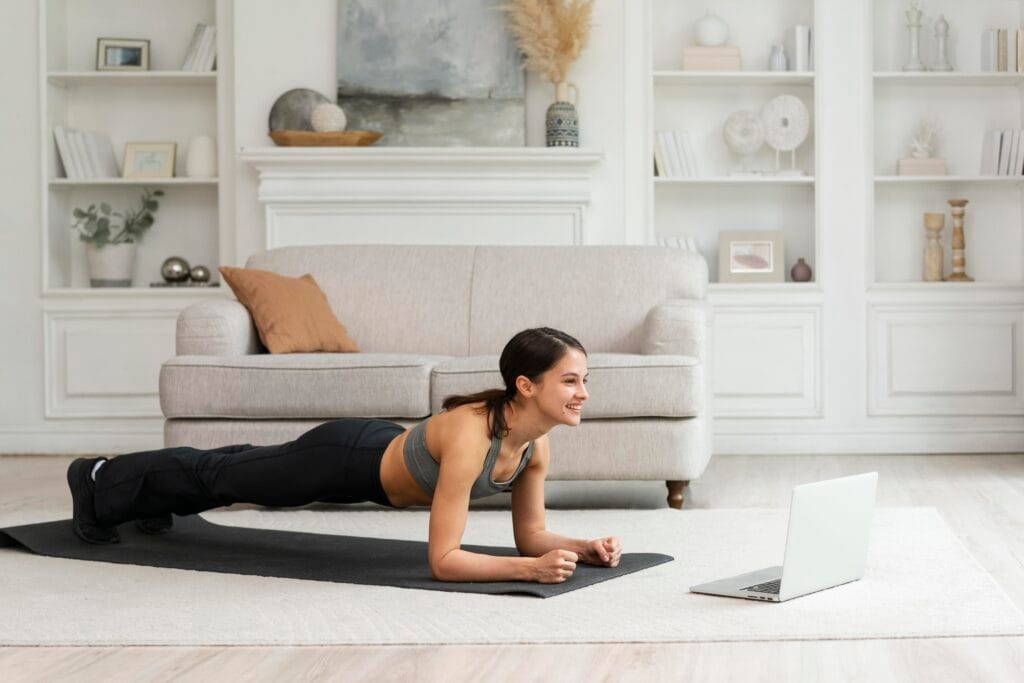How to Create a Customized Home Workout Routine for Busy Professionals?
- Published -
- Reading Time: 7 minutes
-
Written by - Rajat N
- Reviewed by - Dr. Josh Johnson

Although productivity peaks by as much as 21% upon regular engagement in physical activity, over 80% of working professionals admit to having a difficult time working out consistently. As a professional, the daily battle between scrunching in a workout schedule around your hectic routine can be a common scene. But the internal struggle does not have to be that dreary: achieving fitness goals does not always imply sacrificing countless hours at the gym.
If gym hours elude you, one viable option is to develop a calendar based home workout plan that fits your fitness needs as well as your activities. We’ll delve into how you can follow along whilst destroying popular misconceptions, analyzing expert opinions, and relating with real life scenarios.
source – https://www.youtube.com/watch?v=q3cNAOMLz60
Note: The video content is intended to provide supplementary information and a different perspective on the discussed topic. All information and advice presented in this article are based on expert guidance and review.
1. Performing a Fitness Assessment
Tip: Set goals after determining your existing fitness level.
Solution: Set your baseline first. Look for gaps in your endurance, strength, flexibility, and physical restrictions and take notes about them. This will allow you to define a problem and come up with a solution.
Expert opinion: Dr. Samantha Greene, an accomplished personal trainer, said: ‘Knowing your starting point allows you to set realistic goals and helps in avoiding injuries.’
Case Study: Mark, a software engineer, identified a weak core through a 5 minute test available in a fitness app. By adding core strengthening exercises, he was able to correct posture issues which reduced back pain.
Data Point: A study conducted by the American Council on Exercise shows how fitness assessment at the beginning of every routine increases commitment to the fitness plans by 32%.
Application: “You do not need to be fit to start exercising.” For those looking to start, there are fitness assessments available that do not measure how good one is, but rather help identify areas of improvement.
Myth Buster: Everyone agrees that Fit Gap assessments have become a prerequisite for almost everything these days.
2. Goal Setting: The “how much” Behind the Routine
Tip: These should rank stress relief, weight loss, strength building or even muscle toning.
Solution: Try to develop SMART goals (Specific, Measurable, Achievable, Relevant, Time-bound). “Achieving 5 pounds weight loss in eight weeks is possible by exercising for four days in a week,” he said.
Expert opinion: “Your ‘why’ contextualizes your goals and provides motivation for achieving them,” says wellness coach Jenna Carter.
Case Study: Mushira, an attorney, wished to enhance her mental health and started doing yoga as part of her daily routine. Within two months, she felt 40% less stressed, which was a welcomed change.
Data Point: According to a 2022 report collected by the CDC, those with clearly defined goals are 42% more likely to regularly meet fitness activities.
Myth Buster: It is not necessary for the goals to be exceptionally ambitious for them to bear fruit. Making tiny incremental changes over a while can lead to valuable outcomes.
3. Do Workouts That You Can Integrate Into Your Daily Life
Tip: It is best to choose exercises that need little equipment and time.
Solution: Take a mix of body weight exercises (push-ups, squats, planks) and add short cardiovascular exercises (jumping jacks, burpees). If that is too boring, try online workout sites or fitness apps.
Expert Insight: As Alex Morgan, fitness trainer puts it, “The most effective workout is the one you are most likely to stick with, and if your goal is to lose 20 pounds, of 15 minutes every day is all you can imagine committing to, that would be a welcome short term change. Aim for longer workouts when you are in better mental health and have more energy. What’s more important than the quantity of time is how the time is spent.”
Case Study: A marketing manager named Ravi began incorporating 15 minutes of high-intensity aerobic exercises into his routine 3 times a week. After 6 weeks, he noticed an increase in his energy levels by 25%.
Data Point: HIIT workouts promote an improvement in cardiovascular health by 17% in just 8 weeks, as stated in a Journal of Sports Science.
Myth Buster: Gym access should not deter you from exercising. You can get in shape by utilizing your body weight and household items like chairs and water bottles.
4. Schedule the Workouts
Tip: Get the time of your day that you spare regularly and ensure to use that to exercise.
Solution: Decide on an exercise time that suits your daily agenda and energy levels, be it a morning 6:00 AM workout session or 9:00 PM stretches before going to sleep.
Expert Insight: Dr. Emily Hayes states, “Focused Consistency is the most imperative step to take. Even 10 minutes a day, consistently completed, results in a habit being created.” She is a behavioral psychologist by profession.
Case Study: John, a project manager with a tight schedule, started exercising at 7 in the morning. After around three weeks, he felt more active and alert during meetings that happened in the mornings.
Data Point: Duke university has published a report demonstrating that 68 percent of individuals who exercise consistently at one time tend to be more disciplined.
Myth Buster: You do not have to leave bed early to reap the benefits of sleeping workouts. The best time to train is when you feel like working out.
5. To Avoid Reaching a Workout Plateau Implement Variation
Tip: Combine a mix of strength, flexibility, recovery, and cardio workouts in that order.
Solution: Establish a weekly schedule within your routine: strength training on Monday, yoga on Wednesday, and cardio on Friday. Sunday can be dedicated to stretching or resting.
Physiotherapist Dr. Laura Chen supports the notion that “Variety keeps your muscles guessing and prevents boredom,” even at work.
Priya’s case demonstrates how pilates, strength training, and Zumba helped her develop a love for dancing while shedding weight. Priya, an avid coffee drinker, claimed to have lost a total of 8 pounds.
A recent investigation in the Journal of Applied Physiology showcased how varied workout plans and mixed exercise routines could yield the increased calories burned outcome by as much as 30%.
Mixing exercise in one’s routine through incorporating easier and more difficult sets of exercises will help maintain muscled needed stamina. One’s body will have to take time adjusting which is why explosive muscle camping is never effortless.
6. Technology Can Help People Stay on Track as Well
Wearable fitness trackers, virtual classes and apps are amongst the best options available.
To stay motivated, one can always set new goals and join online groups to keep the improvement going.
Tech fitness coach Rachel Turner argues that with the right mindset around exercise, one can achieve great things and treats fitness as a fun challenge instead of a burden.
According to a report released by Statista in 2023, Alex had increased his activity by 35% after three months of tracking his steps and calories with a smartwatch.
Exercise is not confined to experts. All exercise buffs can benefit greatly from controlled routines and effective tracking.
7. Active Recovery is Essential, So Try not to Ignore It
Building in muscle activation sessions followed by foam rolling or stretching is crucial to enhancing muscle healing.
Solution: The rest days allow for muscle repair and growth. Add 5-10 post workout stretches to increase flexibility and reduce soreness
Expert Insight: “Recovery is just as important as the workout itself. Overtraining leads to fatigue and injuries,” says sports scientist, Dr Raj Mehta.
Case Study: Nina, a management consultant, ignored recovery in the beginning and suffered from numerous muscle strains. After implementing yoga and rest days, her performance greatly increased.
Data Point: Continuous active training with no breaks can be harmful. Studies show active recovery improves performance by 15%.
Myth Buster: Rest days are not signs of weakness. They are essential in the long run.
8. Track Progress and Celebrate Milestones
Tip: When it comes to weighing yourself, take pictures, fitness apps, or journal entries as ways to measure progress.
Solution: Think of all the non-scale victories such as increased mood, sleep, stamina …
Expert Insight: “Celebrating small wins keeps you motivated and engages positive behavior,” says life coach, Maya Singh.
Case Study: David, a busy architect, maintained a fitness journal to motivate himself as well as document improvements.
Data Point: Tracking progress boosts motivation by 34%, as documented by a study of the American Psychological Association.
Myth Buster: Progress is not limited to weight loss. Strength, endurance, and mental clarity ought to be considered too.
Conclusion:
Your Fitness Journey Start Recall Fitness Ventures Commencing Today
An effective workout plan for home use need not be catastrophically difficult. A careful understanding of your strength level alongside reasonable goal setting, varying one’s workout, and adapting to a busy life will produce amazing outcomes.
With that being said, do not forget that health is a process. Focus on small and realistic objectives and the improvements you experience will be seen and felt.
FAQs
- How do I start exercising at home as a novice?
Answer: Begin with basic bodyweight exercises such as squats, push-ups, planks and lunges. Perform each exercise for 30 seconds with rests between them lasting from 15 to 30 seconds. Start with two or three sessions weekly and increase their intensity in the meantime.
- What is the amount of time that should be allocated to home workouts?
Answer: Aim for at least 20-30 minutes per session,3-5 days per week. Intense physical activity (e.g., HIIT) can work well with busy professionals who want maximum results within a shorter duration of time.
- Do I need any special equipment to workout at home?
Answer: No, equipments are not required. You may use body weight exercises but simple tools like stretch bands, dumbbells or even household equipment like bottles filled with water and chairs can provide you variation and resistance during your workout periods.
- How do I maintain my commitment to my exercise routine while still being able to meet other obligations?
Answer: Plan your workouts on your calendar.
Select an ideal time of day for you either morning hours or break times.
Begin small (at least ten minutes daily) before expanding it into a habit forming process.
Use fitness apps or notifications as reminders for staying on track.
- Can I accomplish my fitness aims with small workouts?
Answer: Certainly! Recent studies have shown that even high intensity exercise for 10-15 minutes can increase cardiovascular health, body power and endurance. It should be noted that quality rather than quantity is important here; therefore each session should be well organized and grueling.
- How can I make my home workout routine more diverse?
Answer: You could try mixing up different types of workouts like; Weightlifting (bench press, deadlift), Aerobics (running on the spot, squat jumps), Soccer/Football (ball juggling), Dance, Etc.
To avoid monotony, change your regimen in parts every few weeks.
- Is it all right to skip rest days if I am motivated to work out daily?
Answer: No. Rest days are crucial for muscle recovery, injury prevention and performance improvement. Active recovery might include walking or stretching on rest days so one is not completely sedentary while avoiding overtraining.
- How do I determine progress in a home workout routine?
Answer: Record progress through:
Using fitness apps or journals to log your exercises
Taking Progress photos which show changes over time
Performance benchmarks such as improved pushups or increased duration of planks hold
Non-scale victories like better mood, sleep and energy levels
- What if I don’t feel like exercising at home?
Answer: Begin with small goals that you can achieve.
Designate a separate area for your workouts to avoid being disturbed.
You may take advantage of workout apps, virtual classes, or working out together with someone else as an accountability measure.
Remember why you started the journey towards your fitness goals.
- Can I lose weight or build muscle with just home workouts?
Answer: Yes, losing weight is possible by doing regular exercises at home and combining them with eating the right food. If your goal is to shed some pounds, opt for activities that burn calories such as cardio and high-intensity interval training (HIIT). To enhance the size of muscles on the other hand, resistance or bodyweight strength training should be given priority alongside progressive overload principles.





